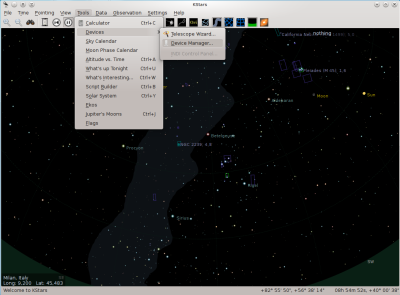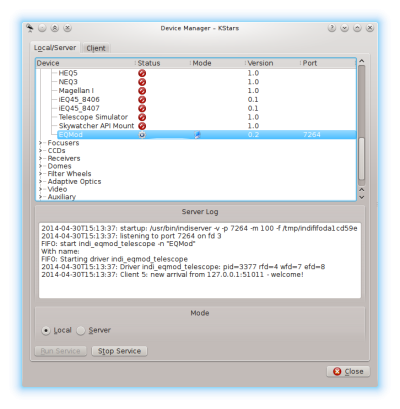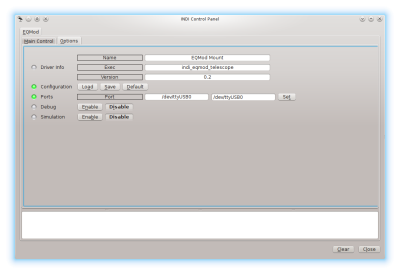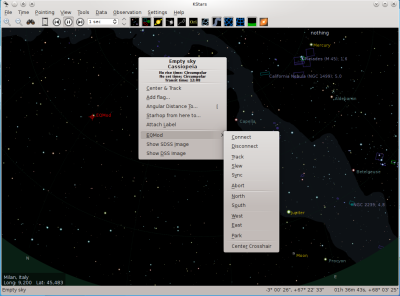Notice: this article is currently available in italian only.
I will translate it soon. You may contact me via comments if you want me to “prioritize” this article first.
Altre riprese delle macchie solari, in una giornata in cui la nostra stella era particolarmente ricca di dettagli.
In questo caso, essendoci parecchie macchie a fare da punti di riferimento, sono riuscito a fare un buon numero di riprese sovrapponibili per creare un mosaico (purtroppo non completo).
Sun Spots - 2014 07-06
Sono circa una decina di immagini da 400 frames ciascuna (su 1000 totali).
L’elaborazione è stata fatta sempre con registax, l’unione del mosaico con Hugin.
Notice: this article is currently available in italian only.
I will translate it soon. You may contact me via comments if you want me to “prioritize” this article first.
template<typename T>
class Fill {
private:
T *array;
long _size;
T _value;
public:
Fill(T *a) : array(a) {}
Fill &size(long s) { _size = s; return *this; }
Fill &with(T value) { _value = value; return *this; }
~Fill() {
for(long i=0; i<_size; i++) array[i] = _value;
}
};Utilizzo snippet:
int array[10];
Fill<int>(array).size(10).with(1);Ecco un po’ di teoria di cosa succede.
RAII è una tecnica che permette di sfruttare una caratteristica del c++ che lo differenzia dai linguaggi con garbage collector (Java, ad esempio): la certezza di quando il distruttore della classe verrà chiamato.
L’idea è di sfruttare entrata ed uscita dallo scope di una variabile per effettuare acquisizione e deallocazione delle risorse. O per dirla in altri termini, per eseguire istruzioni all’ingresso e all’uscita di uno scope.
In questo caso stiamo creando una istanza anonima della classe Filler.
Alla sua inizializzazione passiamo al costruttore
Fill<int>(T *a) : array(a) {}un array, che vogliamo riempire. Il costruttore lo memorizzerà nel suo field “array”.
Con il metodo “size” diciamo quanti elementi dell’array vogliamo riempire, mentre col metodo “with” impostiamo il valore con cui riempire l’array.
Entrambi questi metodi tornano un riferimento a “this”, ossia all’istanza corrente, in modo da “tenerla viva” nello scope, e permettendo di effettuare method chaining.
Infine, quando la variabile scompare dallo scope (ossia subito, visto che è anonima), viene chiamato il distruttore, che contiene il ciclo for che riempie l’array col valore che abbiamo impostato.
E’ interessante notare come, non essendoci nessun metodo che esplicitamente riempie l’array, l’ordine delle chiamate è perfettamente invertibile: avrei infatti potuto ugualmente scrivere
Fill<int>(array).with(1).size(10);E funzionerebbe nello stesso identico modo, dato che il riempimento vero e proprio verrà comunque effettuato nel distruttore.
Si tratta ovviamente di un esempio relativamente banale, ma che fa intuire la potenza della tecnica.
Basti pensare ad altre applicazioni, come l’apertura di un file con chiusura automatica quando la variabile RAII esce dallo scope, o una transazione che inizia nel costruttore, e viene automaticamente committata nel distruttore, o addirittura, nel c++11, l’esecuzione di una lambda quando la variabile RAII esce dallo scope.
class Scope {
public:
Scope(std::function<void()> onExit) : _onExit(onExit) {}
~Scope() { _onExit(); }
private:
std::function<void()> _onExit;
};RAII viene molto usato sopratutto per gestire al meglio le eccezioni: non è infatti necessario un blocco finally come in Java, dato che sia in caso di eccezione che nel flusso normale la variabile viene comunque deallocata, e il distruttore invocato.
Notice: this article is currently available in italian only.
I will translate it soon. You may contact me via comments if you want me to “prioritize” this article first.
Dopo aver collimato un po’ meglio il telescopio, ho approfittato di una mattinata con un seeing tutto sommato accettabile per effettuare altre riprese del sole. Domenica 8 giugno il sole si mostrava particolarmente ricco, con un gruppo di macchie in particolare molto vicino, proprio al centro dell’astro, come mostrato dalla ripresa della sonda SOHO.
I gruppi da me ripresi sono il 2080-2085, molto estesi, e il 2082. Qui le riprese:
Sun Spots - 2014 06 08
Sun Spots - 2014 06 08
Notice: this article is currently available in italian only.
I will translate it soon. You may contact me via comments if you want me to “prioritize” this article first.
Sempre per ingannare l’attesa del prossimo novilunio (e che almeno stavolta sia il meteo sia clemente), ho deciso di investire un po’ di vil denaro per acquistare una videocamera dedicata per la riprese planetarie, dato che il soggetto mi ha sempre attirato parecchio.
Si tratta di una QHY5L-II, versione monocromatica, sicuramente non il meglio, ma che mi ha molto colpito per il rapporto qualità/prezzo.
Oltre che per la simpatica scatolina di biscotti che viene fornita come custodia :)

Ho scelto una camera bianco e nero per poter avere una risoluzione maggiore, per effettuare riprese a colori sarà sufficiente acquistare dei filtri RGB una volta acquisita confidenza con la fotocamera. Inoltre ho preso la versione “L”, caratterizzata da una Q.E. del 74%. È anche piuttosto veloce, con un frame rate che raramente scende sotto i 30fps anche su soggetti un po’ meno luminosi come Saturno in queste sere, basso ed affogato dall’atmosfera terrestre.
Il software fornito per Windows è decisamente migliorabile, ma preso “con le buone” tutto sommato fa il suo dovere. Piuttosto lento nella scrittura dei fotogrammi su disco. Dovrei provare qualche software di terze parti come FireCapture.
Il supporto per GNU/Linux è parecchio traballante, le applicazioni che la supportano sono poche e funzionano maluccio, ma se non altro il produttore fornisce dei driver open source, e potrei pensare di creare io un’applicazione apposita di gestione della camera per ovviare ai problemi di cui sopra.
Intanto ho già fatto qualche prova, sia pure in condizioni di seeing parecchio svantaggiose. Il sensore si dimostra parecchio luminoso, permette un range di esposizioni particolarmente ampio (dai nanosecondi, fino ai 10 minuti) che lo rende piuttosto versatile. Penso che potrei addirittura provare a fare qualche ripresa su cielo profondo, in un prossimo futuro.
Visto appunto il seeing scarso non pubblico le prove su Saturno e sulla Luna, venute piuttosto maluccio (dovrei uscire ad osservare da qualche parte che non sia la finestra di casa per avere risultati accettabili). Pubblico invece qui in basso qualche prova effettuata sul sole con filtro Baader AstroSolar (neutro), sicuramente ancora molto migliorabili, ma che lasciano già vedere un buon livello di dettaglie sulle macchie, la granulazione, e le facolae.
Sunspots - 17/05/2014
Sunspots - 17/05/2014
Sunspots - 17/05/2014
Notice: this article is currently available in italian only.
I will translate it soon. You may contact me via comments if you want me to “prioritize” this article first.
Mentre il maltempo imperversa impedendo di collaudare a dovere la nuova strumentazione, ne approfitto per fare qualche test “al buio” del nuovo setup, ad esempio per il pilotaggio software. Ho scelto la HEQ5 versione “Syntrek” per evitare la tentazione di abusare troppo del puntamento GOTO, e godere appieno del piacere “da smanettone” di riuscire a far tutto da se, compreso puntare quella galassietta particolarmente debole senza l’ausilio dell puntamento automatico… ma per tutte le evenienze ho comunque preso il cavetto di collegamento al pc, ed è comunque piacevole riuscire a costruire un perfetto sistema sostitutivo del più costoso telecomandino “SynScan” venduto normalmente con la montatura. Qui scriverò un semi-report di quanto son riuscito a combinare, del setup utilizzato, e suggerimenti utili per chi usa una configurazione simile alla mia.
Hardware
Per prima cosa, la montatura ovviamente: la mia è una SkyWatcher HEQ5 SynTrek (senza GOTO appunto). Quanto scritto sotto vale anche per altre varianti, come la HEQ5 con SynScan, la EQ5, o la EQ6, a patto di avere il collegamento al pc corrispondente. Per quanto riguarda il collegamento al pc: esistono due modi per collegare questo tipo di montature al pc. Uno è tramite il telecomando SynScan, che non ho preso appunto. Nel mio caso ho dovuto acquistare un interfacciamento chiamato “EQDIRECT“, che effettua il collegamento dalla porta della montatura (di tipo RJ45) a porta seriale o usb del computer. Ci sono diversi modi per acquistare questo tipo di cavo: da chi ha ideato originariamente l’interfacciamento, cioè ShoeString Astronomy, che ha diversi distributori nel mondo, Italia compres, a cloni più o meno simili, come quello che io ho acquistato presso Teleskop Express. Come computer va bene più o meno qualunque cosa, io in particolare utilizzo un netbook, che offre come vantaggi una grande trasportabilità, consumi molto ridotti e notevole durata della batteria.
Sistema Operativo e software non astronomico
Qui c’è decisamente l’imbarazzo della scelta, di distribuzioni GNU/Linux ce ne sono davvero tante, ognuno ha la sua preferita, e ci sono addirittura delle distribuzioni pronte per l’uso astronomico con tanto software dedicato già preinstallato. Io ho installato una variante di Ubuntu, LUbuntu, minimale, snella e veloce, particolarmente indicata per computer meno performanti come i netbook, appunto. Segnalo anche un software non direttamente legato all’astronomia, ma particolarmente utile: powertop, di Intel, che permette di ridurre notevolmente i consumi ed allungare la vita della batteria.
INDI e KStars
Naturalmente l’installazione di questi due software sarà ovviamente diversa per le varie distribuzioni GNU/Linux; per Ubuntu (e derivate, come LUbuntu), si può fare riferimento alla ben documentata pagina Downloads di INDI, che fornisce istruzioni anche per il repository ppa da aggiungere con pacchetti molto aggiornati e completi. In particolare, per la mia HEQ5, bisogna installare anche il pacchetto extra indi-eqmod non presente di default in ubuntu, ma presente nel ppa. Nel dubbio, si può installare il meta-pacchetto indi-full, che conterrà anche altri driver aggiuntivi (INDI può controllare non solo montature, ma anche macchine fotografiche, webcam, focheggiatori, etc etc). Installare quindi anche KStars (sudo apt-get install kstars).
Setup e utilizzo software
Configurare KStars per l’utilizzo della montatura può essere fuorviante, ma i passi da seguire sono comunque abbastanza semplici stando attenti ad alcune accortezze. Anzitutto, esiste un wizard di aggiunta telescopio, ma non è particolarmente più comodo rispetto al gestore dispositivi regolare, quindi useremo solo il secondo. Segue galleria di screenshots, nelle descrizioni di ognuno sono illustrati i passaggi da seguire.
Selezionare questa voce per lanciare il Device Manager INDI
Selezionare “EQMod” tra i telescopi disponibili
Nella Scheda “EQMod” selezionare il tab “Options”. Impostare la porta (dipende dal tipo di connessione usata), quindi per memorizzarla, premere il pulsante “Save”.
Pagina principale del dispositivo. Da qui possiamo vedere lo stato, le coordinate puntate, e le opzioni per il tracking. Come primissima cosa, per abilitare le operazioni, abilitare il tracking “Sideral”.
Nel tab “Motion Control” possiamo controllare manualmente la montatura per puntare e correggere. La combo “slew presets” ci permette anche di scegliere la velocità con cui effettuare i movimenti
Tornando a KStars e cliccando col tasto destro sul cielo (o ancor meglio su un oggetto) vediamo comparire la nuova voce di menù “EQMod” che ci permetterà di controllare la montatura.
Dall’ultimo screenshot sono particolarmente utili le seguenti azioni:
- Center Crosshair: sposta l’inquadratura di KStars centrando la zona di cielo puntata dalla montatura.
- Sync: particolarmente importante, permette di allineare la montatura. Non avendo encoders assoluti infatti, bisogna comunicare al software quale zona di cielo stiamo puntando per allineare la montatura. Possiamo quindi inquadrare manualmente una stella conosciuta col telescopio, selezionarla su KStars col tasto destro, e quindi cliccare Sync per effettuare l’allineamento.
- Track e Slew, permettono invece di muovere la montatura verso l’oggetto selezionato.
Questo è quanto per un funzionamento “base” di KStars e INDI. In realtà il software è particolarmente ricco di opzioni e funzionalità, e merita sicuramente menzione Ekos, un tool interno a KStars particolarmente avanzato e molto indicato per astrofotografia, che offre molte opzioni utili per la ripresa delle immagini, la messa a fuoco (sia automatica che manuale), correzione automatica degli errori di puntamento della montatura, e tanto altro. Spero di testarlo a dovere, per approfondire l’argomento in un prossimo post.
Notice: this article is currently available in italian only.
I will translate it soon. You may contact me via comments if you want me to “prioritize” this article first.
Giusto qualche appunto per “festeggiare” l’upgrade della mia strumentazione astronomica 🙂
Dopo un po’ di anni di fedeltà al mio newton 130/650 (per la verità non ancora sfruttato abbastanza, ma tanto sarà sempre lì pronto per nuove avventure) ho deciso che era il caso di prendere qualcosa di un po’ più impegnativo.
Il nuovo telescopio è un tubo ottico Meade ACF 8″ (203mm), usato d’occasione, trattato davvero bene, su montatura equatoriale HEQ5.
Un telescopio particolarmente generico: ottimo per l’osservazione visuale, ottimo per l’astrofotografia (prima o poi comincerò ad applicarmici, anche se spero di conservare sempre il mio “spirito visualistico” 😛 ), ottimo anche per l’osservazione dei pianeti, che in mancanza di occasioni migliori per collaudare le ottiche hanno comunque regalato qualche soddisfazione.
A presto per l’inaugurazione sul campo, spero 🙂
In the last few months I started again deditcating more time on astronomy and star gazing.
To better organize my star gazing sessions I started developing a software capable of suggesting celestial object from various catalogues, choosing them among the best visible ones for the selected date and place, and that’s how SkyPlanner got started.
SkyPlanner has many features useful for visual observations: it allows searching and even suggests many objects from many catalogues, such as Messier, NGC/IC, Abell, Arp, MCG, UGC; provides information about the star gazing session, for instance weather, sun and moon rise/set time, moon phase; allows you to set your own telescopes, automatically estimating each object difficulty for the selected instrument; downloads preview images of the object field from the Digitized Sky Survey Archive, presents additional catalogue information and allows you to set your own notes before and after the visual observation.
The objects list is automatically sorted by transit time, creating a printer-friendly star gazing schedule.
I hope this software will help many of you organizing your best star gazing sessions!
I’m open for suggestions, feedback and error reporting, both in my blog here, or through SkyPlanner feedback form page. A more detailed features list and review is in this page.
Happy star gazing!
As i wrote some days ago, I planned on doing some hack so control KStars with a Wiimote.
It turned out KStars isn’t the right target, as it seems to have no plug-in support (and I don’t want to modify core yet, as i’m still in an experimental phase).
But reading data from wiimote and correctly interpreting was already done some days ago, thought it was a little bit hard, so I switched to Stellarium instead.
This is the result:
Of course it’s just experimental code, it’s barely usable.. but it’s a start.
Source is here: https://github.com/rockman81/StellariumWiimotePlugin
Now some technical stuff:
The Wiimote gyro sensors aren’t easy to read, as they don’t send you current angle, but only
It doesn’t report current angle, instead it does report angular speed.
But afterall you can deduce current angle just dividing speed by elapsed time between each message report.
I had to do some tries before finding the proper way of “moving view window” on Stellarium.
It’s not so well documented, and i’m not exactly happy about current solution, but it works, and i’ll ask some help in their mailing list soon.
This solution anyway is easier than i thought, as it only receives as input angles delta, meaning it’s also easy to “align” your telescope to stellarium (just point an object with telescope, then manually point stellarium to that object).
What’s missing:
- better calibration (angles “seem” correct, but i’m not entirely sure…)
- better movement translation (i’m ignoring one axis, they should be all taken into account, and compensate misalignment).
- Maybe some alternative way of displaying wiimote data in stellarium, such as a “virtual” object in sky. this way you can see how close is your telescope to a desired object.
- Equatorial mount support (currently if there is an axis rotation it’s not detected and properly corrected, and it’s interpreted the wrong way).
- ….many other stuff, but it’s too early to get a detailed list 😛
Finalmente sono riuscito a finire l’elaborazione di un insieme di riprese lunari che avevo girato ad agosto 2011.
Ci ho messo parecchio sia per mancanza di tempo, sia perchè per elaborare avevo bisogno di registax.. che però esiste solo per windows (e io windows, per definizione, non lo avvio praticamente mai...).
Alla fine sono riuscito a capire come farlo funzionare con wine su Linux, senza fargli occupare tonnellate di RAM (il grosso problema è che con registax con wine non gestisce gli AVI compressi... ma esportando l’avi in immagini PNG è miracolosamente andato), e quindi a riprendere l’elaborazione.
Dati di ripresa: ho usato un Celestron Astromaster 130EQ, focale 650mm, fuoco diretto.
Webcam Microsoft Lifecam HD 3000, risoluzione 1280×720 (un po’ troppo rumorosa sugli oggetti deboli, ma tutto sommato accettabile per uso astronomico).
Ho elaborato i filmati con Registax 6, quindi messo insieme il mosaico con Hugin, splendido software Open Source (si, anche per Linux, niente wine quindi).
Il mosaico risultante è stato poi rielaborato con Gimp.












